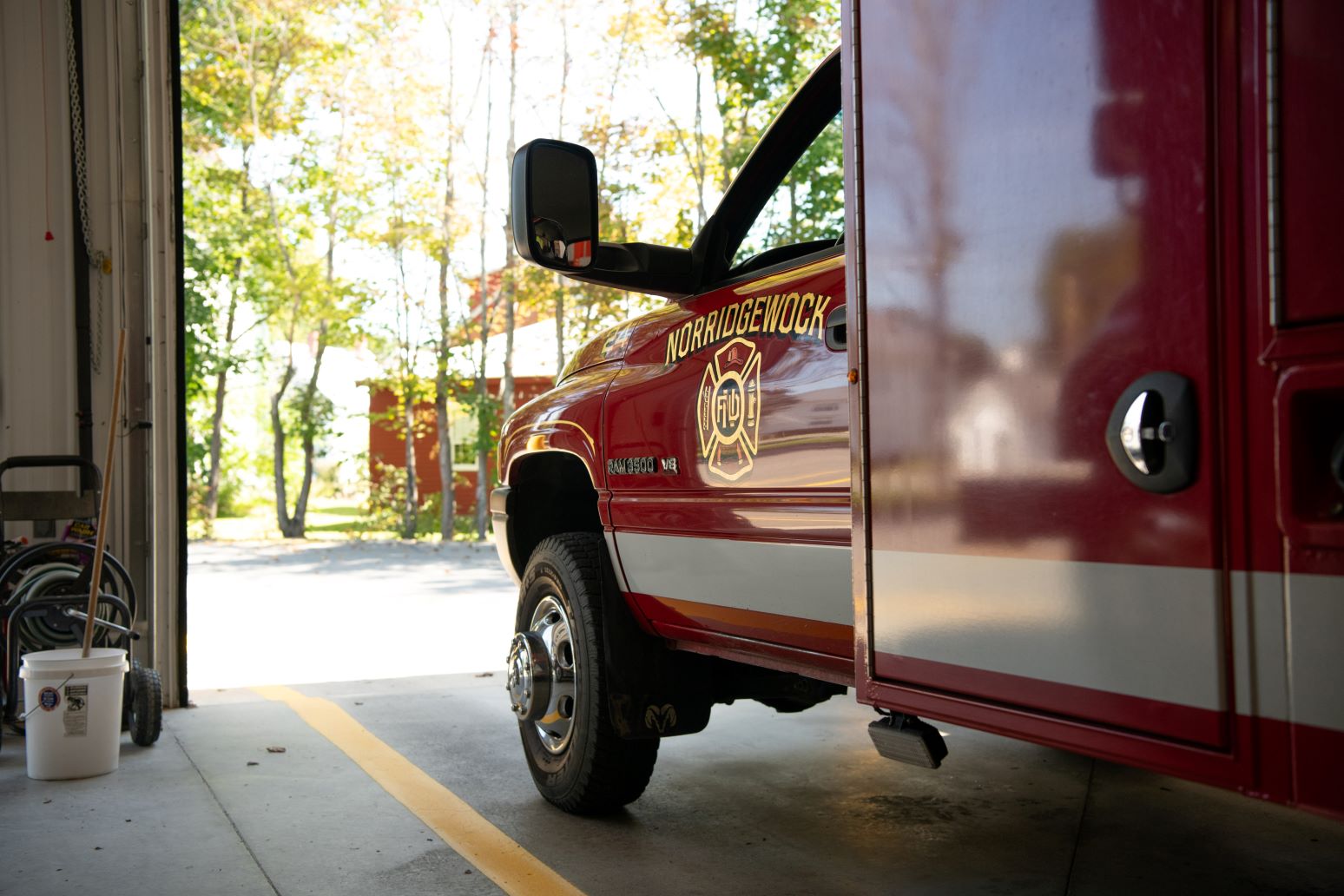The arid conditions that choked Maine into a drought this fall stand in stark contrast to the blanket of precipitation that inundated the state a year ago.
When an atmospheric river threatened to bring a deluge of rain and snowmelt to Maine earlier this month, parched waterways helped shield valley towns from the flooding they saw last December.
It wasn’t just luck. Farmington town manager Erica LaCroix said the modest infrastructure projects and emergency response protocols that the town has completed in the flooding’s aftermath gave her confidence that her community was better prepared for a potential disaster.
Weak, undersized culverts have been expanded, and emergency resources have been moved out of flood zones. LaCroix and other inland Maine town officials have strengthened their communication protocols to share resources and streamline their emergency response plans.
Over the past twelve months, Farmington and other Franklin County towns have participated in a number of county-led disaster response exercises and have created contingency plans for various worst-case scenarios, all with the expectation that more severe floods are imminent.
“We all have an eye towards where we can partner with each other, try to mitigate the cost for our taxpayers and also have a better response,” LaCroix said. “We can all have our separate services, but a lot of times, because of geography, the closest response could be in another town.”
But after a year of ruminating on what went wrong in 2023 and recovering from the $20 million in estimated damages, some western Maine towns have reached the limit of what they can achieve on their own.
The state has doled out $60 million in storm recovery funds to businesses, working waterfronts and infrastructure projects — including $1.05 million to strengthen Norridgewock’s water main against flooding.
But federal disaster aid has been slow to trickle down and many towns lack the technical expertise required to bolster their infrastructure to the levels they’re striving for in the face of climate change.
Even larger towns like Farmington need help fronting costs and navigating federal permitting processes. A year later, LaCroix says the town still hasn’t seen a cent of the $482,875.13 promised by the Federal Emergency Management Agency for recovery costs, causing Farmington to carry a deficit until Maine forwards the funds to the town.
In smaller communities, limited town budgets could put those projects out of reach.
“Supporting that kind of additional cost on a major project is burdensome, particularly for town-meeting towns,” LaCroix said. “When you’re telling people you need to do a project that costs several million dollars, and you’re going to have to borrow a lot of it, it’s hard to get past town meetings.”
Pushing forward
The towns aren’t the only ones grappling with how to move forward. State agencies, too, have spent the year reflecting on last winter’s devastating flooding. In November, the state released a climate resilience playbook and a roster of state officials that can get Maine there — it’s just a matter of funding and execution.
Many of the recommendations outlined in the Infrastructure Rebuilding and Resilience Commission’s interim report address the barriers that Farmington and other towns have identified: the prohibitive cost of resilience projects, complex grant applications and highly technical permitting processes.
One robust section details how Maine can help communities prepare for disasters by pointing to examples from other states, and outlines the creation of a new state office focused on municipal planning.
Born out of a legislative mandate and recommendation from Gov. Janet Mills’ administration, the freshly minted Maine Office of Community Affairs intends to be a “one-stop shop” that can provide coordinated and technical assistance to towns and tribal communities throughout the state.
Though many of its 30 or so anticipated staff members come from reorganizing other state agencies, part of a $69 million federal grant will fund four new positions that will form the state’s Resiliency Office, according to Samantha Horn, director of the Office of Community Affairs.
That includes a resiliency coordinator who will be a direct tie between regional planning offices and state government, linking communities to the resources they need for their larger infrastructure projects.
In Farmington, that kind of assistance could help the town realize its dream of raising a low-lying commercial hub that was under six feet of water last year when the Sandy River spilled over its banks. Some businesses there took months to re-open, while one shuttered for good.
“That’s the only thing that will fully mitigate that area, is raising it,” LaCroix said. “If we could get some help at the state level to even help us through permitting, and maybe not financially help us, but give us some extra guidance, some training, then maybe some of this we can do with our own personnel in-house.”
The state commission’s interim report highlighted a program in Vermont that provides free technical assistance to qualified flood-impacted communities, a service similar to what Horn hopes her office can provide in the near future.
“I think what is needed at this point is some connective tissue so that communities have an easier time navigating resources,” Horn told The Maine Monitor. “That way they spend more time doing the projects and less time finding the grants and technical assistance they need.”

In Norridgewock, town manager Richard LaBelle has seen his community largely recover since the Sandy and Kennebec Rivers wreaked havoc on buildings along their banks, but he’s concerned that residents may have rebuilt in the same flood-vulnerable areas that could be knocked out again in the next storm.
“Our local regulations don’t deal with that necessarily,” LaBelle said on the eve of this December’s projected storm. “I think folks are maybe operating under the misconception that that’s never going to happen again in our lifetime, and unfortunately, we’re looking at it 12 months later.”
LaBelle sees floodplain ordinances, which would prevent new development in the highest risk areas and reduce flood risk in floodplains, as the only way to guide future sustainable development. Horn said her office will be able to guide towns like Norridgewock through this process.
The state plan acknowledges that housing options in Maine are limited but is encouraging communities to pursue smart growth.
“The governor has just pushed so hard to make sure we’re making resources available to communities so that they can do preventative measures as well as recover,” Horn said. That way “when they build back, they build back in a way that’s going to last for a long time.”
Expecting the unexpected
As deputy director of Franklin County’s Emergency Management Agency, Sara Bickford concedes that it’s impossible for Franklin County to plan for every curveball thrown by unpredictable storms like last December’s, but that hasn’t stopped the county from trying.
This July, the county partnered with the National Weather Service to drill towns on how they’d respond to a tropical storm hitting Maine with high winds and extreme flooding — all during the week of the Farmington Fair. When participants thought they had a situation under control, organizers would throw a wrench into their plans and keep them on their toes.
“We had really really good participation, without that our efforts aren’t as valuable,” Bickford said. “There’s something to be said for all of us going through the flood and then coming together even stronger.”
One national expert believes Maine and New England could be uniquely positioned to demonstrate model emergency management policies for the rest of the country.
Not yet burdened by the same amount of climate change-fueled storms as places like Louisiana, New England has more resources and a depth of knowledge to get ahead on planning, according to Samantha Montano, an assistant professor of emergency management at Massachusetts Maritime Academy.
“We have the breathing room right now and the potential resources and knowledge to make really significant reforms to how we’re doing emergency management,” Montano said, which will “set us up for when those bigger disasters come and also potentially be a model for other parts of the country.”

Potential reforms include increasing the number of professional emergency managers at the municipal level (roles often occupied by town managers today), redesigning communities to accommodate flooding and undertaking a massive public education campaign on what to do when disasters strike.
Whether supported by state or local funding, expanding the number of emergency managers embedded within municipal governments will also provide a full-time staff member to pursue hazard mitigation grants and ease communities through technical planning processes, Montano said.
Many of these recommendations align with the commission’s proposals. As Horn met with her team for the first time on Thursday, she recognized the significance of the mission ahead of them.
“We’re going to continue to face severe storms,“ Horn said, and “there is an all-out effort to address these issues so that that type of damage doesn’t happen again.”







